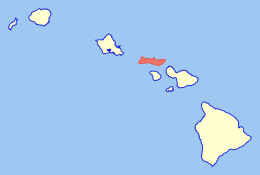Nickname: The Friendly Isle, ʻĀina Momona | |
|---|---|
 Satellite image of Molokai | |
 Location in the state of Hawaiʻi | |
| Geography | |
| Coordinates | 21°08′06″N 157°00′36″W / 21.13500°N 157.01000°W |
| Area | 260 sq mi (670 km2) |
| Area rank | 5th largest Hawaiian Island |
| Highest elevation | 4,961 ft (1512.1 m) |
| Highest point | Kamakou |
| Administration | |
| Symbols | |
| Flower | Kukui |
| Color | ʻŌmaʻomaʻo (green) |
| Largest settlement | Kaunakakai |
| Demographics | |
| Demonym | Molokaian |
| Population | 7,345[1] |
| Pop. density | 28/sq mi (10.8/km2) |
Molokai (/ˌmoʊloʊˈkaɪ/[2]) (Hawaiian: Molokaʻi pronounced [ˈmoloˈkɐi, ˈmoloˈkɐʔi][3]) is the fifth most populated of the eight major islands that make up the Hawaiian Islands archipelago in the middle of the Pacific Ocean. It is 38 by 10 miles (61 by 16 km) at its greatest length and width with a usable land area of 260 sq mi (673.40 km2), making it the fifth-largest in size of the main Hawaiian Islands and the 27th largest island in the United States.[4] It lies southeast of Oʻahu across the 25 mi (40 km) wide Kaʻiwi Channel and north of Lānaʻi, separated from it by the Kalohi Channel.
The island's agrarian economy has been driven primarily by cattle ranching, pineapple production, sugarcane production and small-scale farming. Tourism comprises a small fraction of the island's economy, and much of the infrastructure related to tourism was closed and barricaded in the early 2000s when the primary landowner, Molokai Ranch, ceased operations due to substantial revenue losses. In Kalawao County, on the Kalaupapa Peninsula on the north coast, settlements were established in 1866 for quarantined treatment of persons with leprosy; these operated until 1969. The Kalaupapa National Historical Park now preserves this entire county and area. Several other islands are visible from the shores of Molokai, including Oahu from the west shores; Lanai from the south shores, and Maui from the south and east shores.
- ^ "Molokai Shows Population Decline Over the Past Decade". Archived from the original on 2019-06-03. Retrieved 2014-10-29.
- ^ "the definition of Molokai". Dictionary.com. Archived from the original on 2016-05-15. Retrieved 2017-10-14.
- ^ Mary Kawena Pukui; Samuel Hoyt Elbert (2003). "lookup of Molokaʻi". in Hawaiian Dictionary. Ulukau, the Hawaiian Electronic Library, University of Hawaii Press.; Mary Kawena Pukui; Samuel Hoyt Elbert (2003). "lookup of Molokaʻi". in Hawaiian Dictionary. Ulukau, the Hawaiian Electronic Library, University of Hawaii Press.
- ^ "Table 5.08 – Land Area of Islands: 2000" (PDF). 2004 State of Hawaii Data Book. State of Hawaii. 2004. Archived (PDF) from the original on 2012-02-01. Retrieved 2007-07-23.